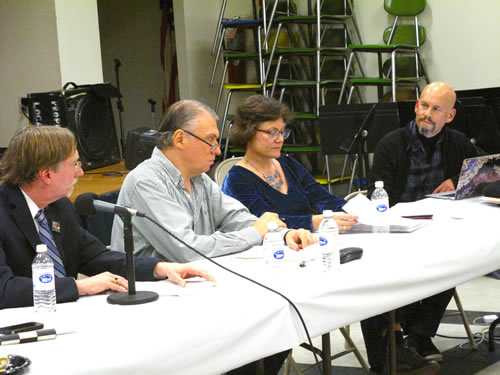Allegro
Come Together
Annual meeting of the RMA-NY takes a close look at tax breaks that may encourage more soundtrack recordings in NYC
Volume 113, No. 3March, 2013

From left to right: Jerry Stoeffhaas (deputy director of the New York State Governor’s Office for Motion Picture and TV Development), Roger Blanc (RMA-NY president), Gail Kruvand (RMA-NY secretary-treasurer) and Marc Sazer (RMA international president).
Recording musicians came together in late January when the New York chapter of the RMA held its annual meeting at Local 802. The featured topic of the night was New York state and city tax credits for film production and post production, particularly as they apply to soundtrack recordings in NYC.
This topic has been a focus for RMA-NY in a big way over the past year, and has been the impetus behind our recent series of articles in Allegro. RMA-NY President Roger Blanc led off the evening with introductory remarks and a president’s report, followed by Secretary-Treasurer Gail Kruvand’s report.
Local 802 President Tino Gagliardi then presented on the subject of Local 802 recording revenues, which overall were up in 2012 from the previous year. 2012 revenues for union film and TV recording in NYC were almost double those of 2010, undeniably good news in anyone’s book. This change alone was clear evidence that the NY tax credits have been having a positive impact on work in our business.
Next to present was K.C. Boyle, the union’s political and public relations director, who spoke in technical terms on the specifics of the tax credits. While complex in nature, the credits have continued to expand into an increasingly advantageous vehicle for film and TV producers, having grown in both scope and coverage (culminating in their recent proposed extension through 2019). These credits have been consistently revenue-positive for the both the state and the city, and it is fair to assume that they will remain viable as long as this continues to be the case.
Board member Shem Guibbory contributed additional information in a similar vein after K.C. had concluded his portion of the presentation.
RMA International President Marc Sazer was the next to take the mic, and he spoke in depth on a broad range of related subjects.
Marc noted significant improvements in the relationship between recording musicians and the AFM. He spoke of progress in discussions with the videogame industry that will hopefully result in settled and lasting relationships down the road.
Marc also focused on the subject of film and television tax credits, proposing that it is wrong for American tax dollars to fund productions that export their musical recording work to offshore locations instead of doing the work here at home with American union musicians. It appears that no other union is singled out for such treatment where taxpayer-funded film tax credits are concerned.
On a related topic, Marc discussed the opportunities that arise in major media centers like New York and Los Angeles where vast numbers of TV shows and movies film in city streets, contending that projects that use our tax dollars and our city services and spaces should treat musicians appropriately.
Marc’s presentation was followed by Jerry Stoeffhaas, deputy director of the New York State Governor’s Office for Motion Picture and TV Development.
Mr. Stoeffhaas spoke in general terms of the efficacy of the film tax credits in a number of the states where they had been put into effect, and how New York was competing successfully with these other venues.
He addressed an unfortunate reality, that the tracking system in place at present makes it difficult for his office to break out statistics on the use of tax credits for music recording from those showing their use in other aspects of production and post-production. This is a regrettable obstacle, one which it is hoped can be somehow addressed in the near future.
Fortunately, his office is also sympathetic to the challenges our union faces in addressing misunderstandings regarding the cost of union music recording, and they are willing to work cooperatively with us in disseminating information within the film community.
Members of the audience interacted enthusiastically with Mr. Stoeffhaas, asking him technical questions about the tax credits and their surrounding politics, all of which he answered in a positive and informative way.
At this point in the proceedings the room was opened up to allow non-members to enter and participate in the meeting.
Among those who joined the meeting were studio owners, music editors, film composers and TV producers.
The conversation during the second half of the meeting was relatively unstructured, but continued to revolve around the topics of film tax credits and their potential role in increasing recording work in NYC.
Newly-appointed board member Eric Hachikian, introduced earlier during the meeting, briefly described his bi-coastal music production business and his personal commitment to union-based activity.
Guest Barry Downes concluded the meeting with a brief discussion of his computer music database and its use during court cases involving copyright disputes.
Refreshments were then made available to the remaining attendees, bringing the successful evening to a close.
This article was written by Roger Blanc for the RMA-NY board.
